The Barlow’s Syndrome Market is estimated to be valued at USD 210.2 billion in 2025 and is projected to reach USD 433.3 billion by 2035, registering a compound annual growth rate (CAGR) of 7.5% over the forecast period.
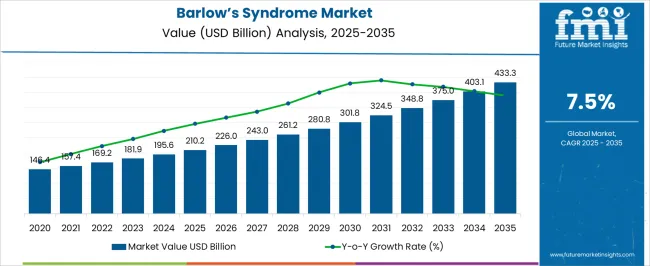
| Metric | Value |
|---|---|
| Barlow’s Syndrome Market Estimated Value in (2025 E) | USD 210.2 billion |
| Barlow’s Syndrome Market Forecast Value in (2035 F) | USD 433.3 billion |
| Forecast CAGR (2025 to 2035) | 7.5% |
The Barlow’s Syndrome market is undergoing gradual yet focused growth, influenced by increasing awareness of valvular heart diseases and the rising prevalence of mitral valve prolapse in both developed and emerging regions. Advancements in cardiac diagnostics, enhanced accessibility to echocardiographic imaging, and the availability of non-invasive treatment options have supported timely identification and management of the condition.
According to clinical journals and cardiology associations, improvements in diagnostic precision, patient education initiatives, and stronger integration of cardiology services at primary care levels are contributing to early detection. Additionally, press releases and hospital network reports have emphasized the growing reliance on pharmacological therapies to manage symptoms and prevent complications, which is shaping the therapeutic approach.
The continued collaboration between healthcare systems and academic institutions has paved the way for structured care models, focusing on cost-effective outpatient management As healthcare infrastructure strengthens and population-level screening increases, the market is expected to witness steady expansion through improved diagnosis, access, and care coordination.
The market is segmented by Type, Treatment, Diagnosis, and End User and region. By Type, the market is divided into Mitral Valve Prolapse, Mitral Valve Regurgitation, and Mitral Valve Stenosis. In terms of Treatment, the market is classified into Medications and Surgery. Based on Diagnosis, the market is segmented into Echocardiogram, X-Ray, Electrocardiogram, and End Users. By End User, the market is divided into Hospitals & Surgical Centers, Specialty Clinics, and Research Institutes. Regionally, the market is classified into North America, Latin America, Western Europe, Eastern Europe, Balkan & Baltic Countries, Russia & Belarus, Central Asia, East Asia, South Asia & Pacific, and the Middle East & Africa.
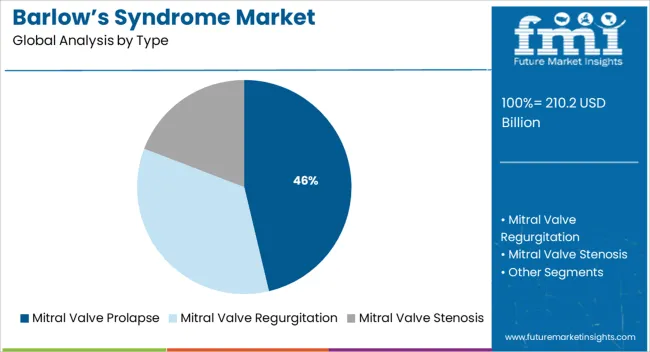
The mitral valve prolapse segment is projected to hold 46.3% of the Barlow’s Syndrome market revenue share in 2025, positioning it as the leading type segment. This dominance has been influenced by its recognition as the most common valvular abnormality associated with Barlow’s Syndrome, as emphasized in recent clinical studies and hospital discharge data. It has been observed that advancements in echocardiographic techniques have improved the detection rates of mitral valve prolapse across various population groups.
The growing incidence of hereditary connective tissue disorders, often linked to this condition, has further reinforced its clinical prominence. Physician education programs and cardiology guideline updates have promoted routine screening and monitoring for mitral abnormalities, which has contributed to greater diagnosis and classification.
The segment’s leading position is also supported by the increasing inclusion of this condition in public health screening initiatives and preventive cardiology frameworks These factors have led to a sustained focus on mitral valve prolapse as the primary classification within the market.
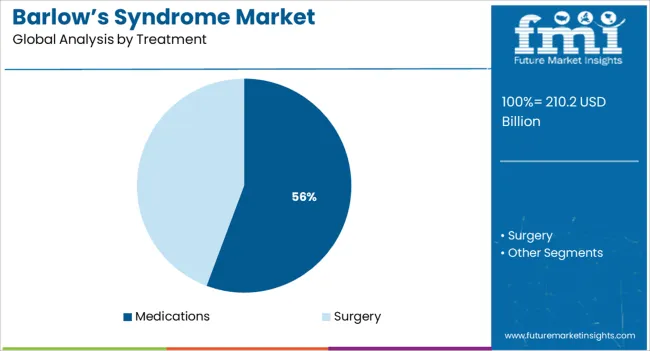
The medications segment is expected to account for 55.7% of the Barlow’s Syndrome market revenue share in 2025, establishing it as the dominant treatment category. This leadership is being driven by the widespread use of beta blockers, antiarrhythmic agents, and other pharmacological interventions aimed at symptom control and complication prevention. As outlined in clinical care protocols and hospital formularies, medications remain the frontline option for managing chest pain, palpitations, and arrhythmias without the need for surgical intervention.
Increasing patient preference for non-invasive therapies and growing physician reliance on long-term medication management plans have further reinforced this trend. Press releases from health systems have noted that pharmacotherapy offers flexibility in outpatient care settings and is easily integrated into primary care routines.
Additionally, the affordability and broad accessibility of medications contribute to their widespread adoption in both high and middle-income regions These advantages have solidified the segment’s stronghold in the treatment landscape of Barlow’s Syndrome.
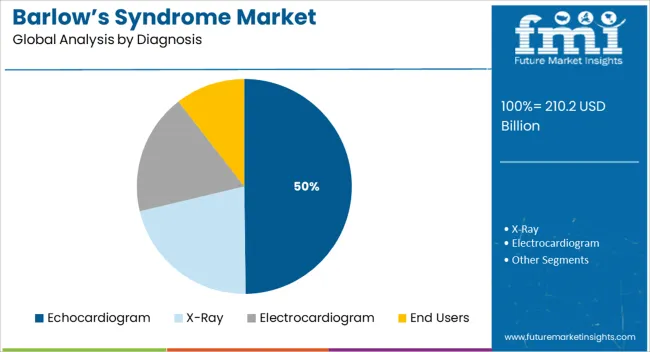
The echocardiogram segment is projected to represent 49.8% of the Barlow’s Syndrome market revenue share in 2025, marking it as the leading diagnostic modality. This position is attributed to its non-invasive nature, high diagnostic accuracy, and routine use in identifying mitral valve abnormalities. Cardiology departments and clinical research updates have consistently highlighted echocardiography as the gold standard for evaluating valve motion, thickness, and regurgitation severity.
The accessibility of portable and point-of-care echocardiographic devices has further enhanced its usage across various healthcare settings. Press statements by medical device companies have also emphasized improvements in image resolution and automation that support faster and more accurate assessments.
Echocardiograms are often preferred due to their repeatability, cost-effectiveness, and safety profile, which makes them ideal for ongoing monitoring of patients with known or suspected Barlow’s Syndrome These attributes have firmly positioned echocardiography as the primary diagnostic tool within this market segment.
According to market research and competitive intelligence provider Future Market Insights- the market for Barlow’s syndrome reflected a value of 9.7% during the historical period, 2020 to 2025.
Nearly 5% to 10% of people in the world suffer from Barlow’s syndrome. This, in turn, has created a huge opportunity for the market. Although the COVID-19 pandemic affected the medication and therapeutic treatment for the market owing to the supply chain disruption across the globe, in the upcoming years, research and development initiatives are expected to positively influence the demand for Barlow’s syndrome market.
Thus, the market for Barlow’s syndrome is expected to register a CAGR of 13% in the forecast period 2025 to 2035.
Numerous health problems are key drivers of the Barlow's syndrome market
Barlow’s syndrome is an abnormality of the mitral valve of the heart. It is a condition in which the leaflets of the mitral valve swell and shifts towards the left atrium of the heart as the valve closes during ventricular contraction. This abnormality prevents the valve from closing suitably, which causes it to leak.
Barlow’s Syndrome can be caused by various reasons, some of which are calcium buildup, congenital heart defects, radiation treatment, and tumors. Additionally, traumatic injury, disease, or infection can lead to Barlow’s Syndrome.
Geriatric population contributing to Barlow's syndrome market growth
The Barlow’s Syndrome market is estimated to lead a healthy growth. The Barlow’s Syndrome market is majorly driven by the increasing geriatric population, rising global population, and rising cardiovascular disorders. According to a report published by the US
Population Reference Bureau, nearly 46 Billion people aged 65 years or more in 2014, and the report estimates that this number would double to reach nearly 433.3 Billion people by the end of 2060. Similarly, the 65-and-older age group would reach up to nearly 24% by 2035 from 15% as of 2020.
Lack of awareness regarding Barlow's syndrome hampering the market growth
Although Barlow’s syndrome is increasing across the globe, the time taken for approval for medications from healthcare authorities is derailing the progress of the market. Moreover, the identification of Barlow’s syndrome in later stages along with a lack of awareness of the effects of Barlow’s syndrome is hampering the growth of the market.
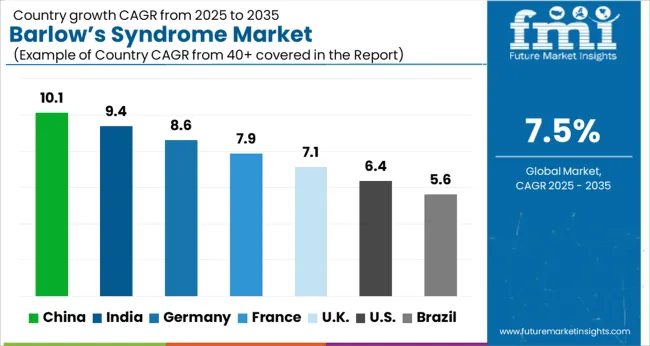
Government healthcare initiatives and growing research and development activities supporting market growth in North America
North America holds the maximum share of the Barlow’s Syndrome market in the Americas region. On a regional basis, the Americas region is segmented into North America and South America. North America is segmented into the USA and Canada. The increasing geriatric population, rising number of cardiovascular disorders, and growing population have increased the scope of the Barlow’s Syndrome market in the North American market.
In addition, the availability of advanced treatment facilities, increasing cardiovascular diseases, and skilled medical professionals are propelling the growth of the Barlow’s Syndrome market in the North American region. Additionally, increasing government healthcare initiatives and growing research and development activities supported by the government to provide better healthcare treatments are likely to boost market growth. Thus, North America is expected to possess a 45% market share for Barlow’s syndrome market in 2025.
Development of healthcare infrastructure and skilled healthcare providers strengthening treatment for Barlow's syndrome
The Asia Pacific is expected to be the fastest-growing Barlow’s Syndrome market owing to the increasing incidence of chronic diseases, and fetal disorders. India is the fastest growing region owing to the increasing population and increasing geriatric population. Rising awareness, the growing standard of living, and the availability of new treatment methods are likely to drive market growth in this region.
Owing to the development of healthcare infrastructure and skilled healthcare providers, China, Japan, and India are expected to account for the largest market share. Thus, Asia Pacific is expected to share 37% market share for Barlow’s syndrome market in 2025.
Precise results and ease of performing tests make echocardiogram a popular test option
On the basis of diagnosis Barlow’s syndrome market is segmented into echocardiogram, electrocardiogram (ECG) chest x-ray, cardiac MRI, Holter monitor, pulse oximetry, exercise stress test, electrophysiology study, and cardiac catheterization.
Echocardiogram has gained immense popularity owing to the accurate results it offers. The test uses sound waves to produce detailed images of the heart. Thus, it is a safer option to determine the presence of Barlow’s syndrome in children. Furthermore, doctors too have recommended and favored the use of einstein’s anomaly owing to the ease of performing the test and the precise results it offers.
Thus, an echocardiogram is expected to possess a 33% market share for Barlow’s syndrome market in 2025.
Favorable reimbursement policies make hospitals a viable option for treatment
On the basis of end users, the Barlow’s syndrome market is segmented into hospitals & surgical centers, and specialty clinics.
The hospital segment is expected to hold the largest market share for Barlow’s syndrome. This is owing to the availability of various treatments and diagnostics in hospitals. In addition, the presence of healthcare experts and cardiologists is playing a key role in the wide usage of hospitals for the treatment of Barlow’s syndrome.
In addition, initiatives by government authorities to support the treatment of Barlow’s syndrome, especially in hospitals are favoring the growth of the same. Moreover, reimbursement schemes and their benefits are making hospitals a go-to option for the treatment of Barlow’s syndrome. Thus, hospitals are expected to hold a 50% market share of Barlow’s syndrome market in 2025.
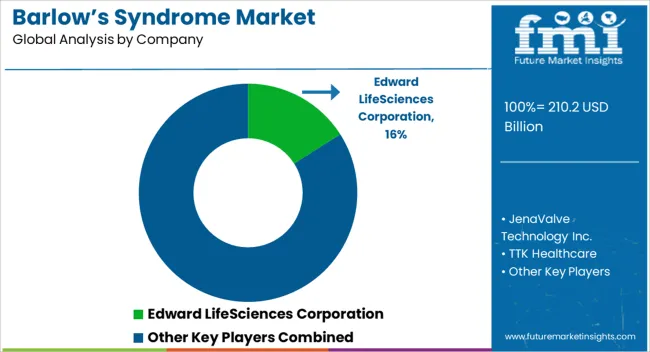
Key players in the Barlow's syndrome market are JenaValve Technology Inc, TTK Healthcare, Lepu Medical Technology Co. Ltd, Abbott Medtronic, Sorin Group, Micro Interventional Devices Inc, Boston Scientific Corporation, CryoLife Inc, Edward Lifesciences Corporation, Medtronic
| Report Attribute | Details |
|---|---|
| Market Value in 2025 | USD 210.2 billion |
| Market Value in 2035 | USD 433.3 billion |
| Growth Rate | CAGR of 7.5% from 2025 to 2035 |
| Base Year for Estimation | 2025 |
| Historical Data | 2020 to 2025 |
| Forecast Period | 2025 to 2035 |
| Quantitative Units | Revenue in USD Billion and CAGR from 2025 to 2035 |
| Report Coverage | Revenue Forecast, Volume Forecast, Company Ranking, Competitive Landscape, Growth Factors, Trends, and Pricing Analysis |
| Segments Covered | Type, Treatment, Diagnosis, End User, Region |
| Regions Covered | North America; Latin America; Europe; South Asia; East Asia; Oceania; Middle East & Africa (MEA) |
| Key Countries Profiled | The USA, Canada, Brazil, Argentina, Germany, The UK, France, Spain, Italy, Nordics, BENELUX, Australia & New Zealand, China, India, Association of Southeast Asian Nations, GCC, South Africa |
| Key Companies Profiled | JenaValve Technology Inc; TTK Healthcare; Lepu Medical Technology Co. Ltd.; Abbott Medtronic; Sorin Group; Micro Interventional Devices Inc; Boston Scientific Corporation; CryoLife Inc.; Edward Lifesciences Corporation; Medtronic |
| Customization | Available Upon Request |
Specialty Clinics
The global barlow’s syndrome market is estimated to be valued at USD 210.2 billion in 2025.
The market size for the barlow’s syndrome market is projected to reach USD 433.3 billion by 2035.
The barlow’s syndrome market is expected to grow at a 7.5% CAGR between 2025 and 2035.
The key product types in barlow’s syndrome market are mitral valve prolapse, mitral valve regurgitation and mitral valve stenosis.
In terms of treatment, medications segment to command 55.7% share in the barlow’s syndrome market in 2025.






Our Research Products

The "Full Research Suite" delivers actionable market intel, deep dives on markets or technologies, so clients act faster, cut risk, and unlock growth.

The Leaderboard benchmarks and ranks top vendors, classifying them as Established Leaders, Leading Challengers, or Disruptors & Challengers.

Locates where complements amplify value and substitutes erode it, forecasting net impact by horizon

We deliver granular, decision-grade intel: market sizing, 5-year forecasts, pricing, adoption, usage, revenue, and operational KPIs—plus competitor tracking, regulation, and value chains—across 60 countries broadly.

Spot the shifts before they hit your P&L. We track inflection points, adoption curves, pricing moves, and ecosystem plays to show where demand is heading, why it is changing, and what to do next across high-growth markets and disruptive tech

Real-time reads of user behavior. We track shifting priorities, perceptions of today’s and next-gen services, and provider experience, then pace how fast tech moves from trial to adoption, blending buyer, consumer, and channel inputs with social signals (#WhySwitch, #UX).

Partner with our analyst team to build a custom report designed around your business priorities. From analysing market trends to assessing competitors or crafting bespoke datasets, we tailor insights to your needs.
Supplier Intelligence
Discovery & Profiling
Capacity & Footprint
Performance & Risk
Compliance & Governance
Commercial Readiness
Who Supplies Whom
Scorecards & Shortlists
Playbooks & Docs
Category Intelligence
Definition & Scope
Demand & Use Cases
Cost Drivers
Market Structure
Supply Chain Map
Trade & Policy
Operating Norms
Deliverables
Buyer Intelligence
Account Basics
Spend & Scope
Procurement Model
Vendor Requirements
Terms & Policies
Entry Strategy
Pain Points & Triggers
Outputs
Pricing Analysis
Benchmarks
Trends
Should-Cost
Indexation
Landed Cost
Commercial Terms
Deliverables
Brand Analysis
Positioning & Value Prop
Share & Presence
Customer Evidence
Go-to-Market
Digital & Reputation
Compliance & Trust
KPIs & Gaps
Outputs
Full Research Suite comprises of:
Market outlook & trends analysis
Interviews & case studies
Strategic recommendations
Vendor profiles & capabilities analysis
5-year forecasts
8 regions and 60+ country-level data splits
Market segment data splits
12 months of continuous data updates
DELIVERED AS:
PDF EXCEL ONLINE
WHIM Syndrome Management Market Insights and Analysis for 2025 to 2035
Marfan Syndrome Management Market Size and Share Forecast Outlook 2025 to 2035
Kounis Syndrome Market Size and Share Forecast Outlook 2025 to 2035
Laband Syndrome Therapeutics Market Growth - Trends & Future Innovations 2025 to 2035
Dry Eye Syndrome Treatment Market Size and Share Forecast Outlook 2025 to 2035
Donohue Syndrome Treatment Market Growth - 2025 to 2035.
Triple X Syndrome Management Market Size and Share Forecast Outlook 2025 to 2035
Edward’s Syndrome Treatment Market – Growth & Future Prospects 2025 to 2035
Sjogren's Syndrome Market Size and Share Forecast Outlook 2025 to 2035
Global Takotsubo Syndrome Therapeutics Market Analysis - Size, Share & Forecast 2025 to 2035
Carcinoid Syndrome Management Market
Carcinoid Syndrome Diarrhea Treatment Market
Short sleep syndrome Treatment Market Growth & Demand 2025 to 2035
Klinefelter Syndrome Therapeutics Market - Growth & Demand 2025 to 2035
Central Pain Syndrome Management Market – Size, Share & Growth 2025 to 2035
Acrocallosal Syndrome Therapeutics Market - Trends & Future Growth 2025 to 2035
Adrenogenital Syndrome Treatment Market Size and Share Forecast Outlook 2025 to 2035
Aarskog-Scott Syndrome Treatment Market - Growth & Innovations 2025 to 2035
Andersen-Tawil Syndrome Treatment Market Trends - Growth & Future Prospects 2025 to 2035
Myelodysplastic Syndrome Treatment Market Size and Share Forecast Outlook 2025 to 2035

Thank you!
You will receive an email from our Business Development Manager. Please be sure to check your SPAM/JUNK folder too.
Chat With
MaRIA